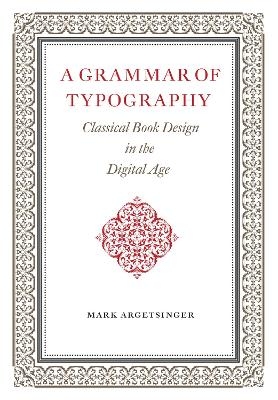
A Grammar of Typography
David R. Godine Publisher Inc (Verlag)
978-1-56792-653-8 (ISBN)
The complete guide to achieving classical type and book design with a keyboard and screen.
How do we absorb the lessons of the printing tradition’s hot metal past and bring them to the digital era? Distinguished designer Mark Argetsinger guides the reader through every aspect of modern book design and production — from the choosing the proper typeface and leading of type to the choice of paper and specifications for binding.
Chapters include “The Classical Tradition,“ “A Short History of Typographical Variations,“ “Desktop Publishing,“ “Composition,“ and “OpenType Fonts and Font Editing.“
Illustrated with over 425 images and diagrams, many in color, Argetsinger discusses and delineates typography as a discipline, situating it among other art forms. Two appendices cover the history of cast-type ornaments and of Greek typography. Throughout there is special reference to the historical printers’ grammars—from Moxon to De Vinne—that serve as a present-day apprenticeship in the traditions of classical typography. Whether a novice or an expert, readers will gain a deeper appreciation for text, and all its rules of form, that can make words on a page a joy to the eye.
Mark Argetsinger is a celebrated designer who has won awards in publication design competitions hosted by the Association of University Presses (AUP), the American Institute of Graphic Arts (AIGA), and the American Alliance of Museums (AAM). Argetsinger is also the recipient of the Carl Hertzog Award for Excellence in Book Design.
Contents
Introduction: The Classical Tradition. A detailed sketch of the establishment of the theory of typographical classicism with Joseph Moxon's architectural analogy. This classicism is situated in the Renaissance rediscovery of the mathematics of Ancient Greece, and its assault by the Modernist school in the 20th century is looked to as source of disorganization of typographic standards today.
Chapter 1: A Short History of Typographical Variations. The forms that typographical letterforms took when cast in lead at the inception of printing are examined in an annotated pictorial survey.
Chapter 2: Type in the 20th and 21st Centuries. The upheavals of typographic letterforms are chronicled through the transition of letterpress to offset printing, and the phenomenon of type revivals and type design in general are examined.
Chapter 3: Desktop Publishing. The technological transition from letterpress to offset and digital printing is further examined through the means of a timeline and commentary on the developments that resulted in the present disposition of desktop publishing.
Chapter 4: Basic Layout-Type. A Short explication of the use of InDesign as medium of typesetting.
Chapter 5: Basic Layout-Images. A Short explication of the use of InDesign as medium of incorporating images within the page.
Chapter 6: Format and Mise-en-Page. The all-important explication of proportions of the page and the disposition of a book's margins.
Chapter 7: Composition. A detailed study of typesetting with a view to its rules for best practices.
Chapter 8: OpenType Fonts and Font Editing. The digital technology of OpenType fonts has brought about the restoration of sound typography to the digital world. And the ability to edit type renders a typographer's powers whole again.
Chapter 9: Page Elements and Make-up of Pages. How type is arrayed on the page and how pages are made-up in a book to best ease and aid readers' comprehension.
Chapter 10: Printers' Manuals and House Style. The trade's standards as expressed in its peculiar literature of the printer's manual and various house styles are examined, along with a draft proposal of a house style for these latter days.
Chapter 11: Proof-Reading and Copy-Editing. Publishing houses used to proof-read and copy-edit to an extraordinarily high standard, which arts have been degraded or eliminated entirely in the new model of self-publishing. These two essential aspects of the book are discussed and an explication of proof-readers' mark is added.
Chapter 12: Paper: The Substrate of the Book. As the drama of highly acidic paper in 19th-century books proved, a book lives by virtue of its paper. A concise history of paper is followed by practical choices for the modern book designer.
Chapter 13: Binding: The Book's Carapace. How a book is bound determines its utility and longevity. A survey of binding history is followed by practical choices for the modern book designer.
Appendices:
1. Typographic Ornament: A Short Overview
2. A Note on Greek Types. An exploration, first, of historical cast-type ornaments, showing examples of contemporary usage, and, second, of the needlessly controversial history of Greek typographical forms.
Annotated bibliography. A selective bibliography of essential or useful books with an annotated characterization of each.
Index
| Erscheinungsdatum | 02.01.2020 |
|---|---|
| Zusatzinfo | more than 425 illustrations |
| Verlagsort | Lincoln |
| Sprache | englisch |
| Maße | 216 x 305 mm |
| Themenwelt | Kunst / Musik / Theater ► Design / Innenarchitektur / Mode |
| Informatik ► Grafik / Design ► Desktop Publishing / Typographie | |
| ISBN-10 | 1-56792-653-3 / 1567926533 |
| ISBN-13 | 978-1-56792-653-8 / 9781567926538 |
| Zustand | Neuware |
| Informationen gemäß Produktsicherheitsverordnung (GPSR) | |
| Haben Sie eine Frage zum Produkt? |
aus dem Bereich


